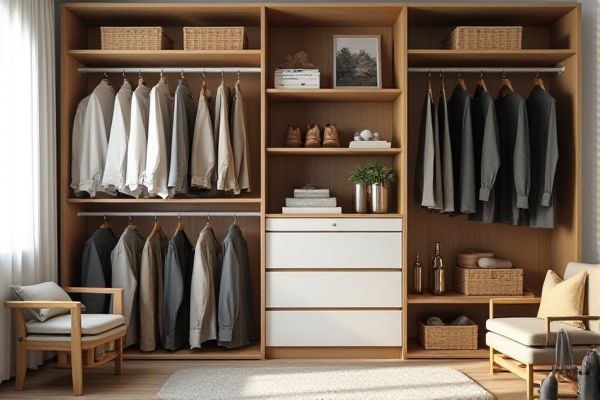
Closet organizers offer customizable storage solutions tailored to fit existing closets, maximizing space with shelves, drawers, and hanging rods, while wardrobe systems provide freestanding units that combine style and functionality, ideal for rooms lacking built-in closets. Discover which option best suits Your storage needs and enhances room organization by reading the full article.
Table of Comparison
| Feature | Closet Organizer | Wardrobe System |
|---|---|---|
| Definition | Modular components to arrange closet space efficiently | Freestanding or built-in full storage solution for clothes |
| Installation | Typically DIY, easy to install | Often professional installation required |
| Customization | Moderate customization with shelves, rods, drawers | Highly customizable with multiple compartments, accessories |
| Space Usage | Optimizes existing closet space | Creates dedicated wardrobe space, can be standalone |
| Cost | Generally lower cost | Higher cost due to design and installation |
| Flexibility | Easy to modify or expand | More permanent, less mobile |
| Ideal For | Improving small or existing closets | Homes without built-in closets or additional storage needs |
Introduction: Closet Organizers vs Wardrobe Systems
Closet organizers and wardrobe systems both enhance storage efficiency but serve different purposes based on your space and needs. Closet organizers typically consist of customizable shelves, rods, and drawers designed to maximize existing closet space, offering flexibility for various clothing types. Wardrobe systems often refer to standalone units that provide complete storage solutions ideal for rooms without built-in closets, giving you a movable and organized space for your garments.
Defining Closet Organizers: Features and Benefits
Closet organizers are modular storage solutions designed to maximize space efficiency by incorporating shelves, drawers, and hanging rods tailored to your needs. They enhance accessibility and organization by categorizing clothing, shoes, and accessories, reducing clutter and saving time. Compared to wardrobe systems, closet organizers offer customizable configurations that adapt to various closet sizes and layouts, providing a personalized storage experience.
What Is a Wardrobe System? Key Characteristics
A wardrobe system is a customizable storage solution designed to maximize space efficiency for clothing, shoes, and accessories. Key characteristics include modular components such as shelves, drawers, hanging rods, and compartments that can be tailored to fit various room sizes and personal storage needs. You can enhance organization and accessibility by integrating lighting, mirrors, and adjustable features within a wardrobe system.
Space Utilization: Which System Maximizes Storage?
Closet organizers offer customizable compartments tailored to maximize every inch of existing space, ideal for optimizing smaller or irregular areas. Wardrobe systems, often freestanding units, provide structured storage with fixed shelves and hanging rods, suitable for rooms with more available space but less flexibility. Your choice depends on how effectively you want to use vertical and horizontal space to maximize storage capacity.
Customization Options: Flexibility Compared
Closet organizers offer a high degree of customization with modular shelves, drawers, and hanging rods tailored to fit your specific storage needs. Wardrobe systems provide a more structured layout but often include adjustable components to accommodate seasonal wardrobe changes. Your choice depends on the level of flexibility and personalization you require for maximizing space efficiency.
Installation Process: Ease and Requirements
Closet organizers typically feature modular components that allow for straightforward installation, often requiring minimal tools and no professional assistance, making them ideal for quick, customizable setups. Wardrobe systems, however, tend to be more robust and may require precise measurements, wall mounting, and professional installation to ensure stability and full functionality. Your choice depends on whether you prefer an easy-to-install, flexible solution or a more permanent, tailored storage system.
Aesthetics and Design Choices
Closet organizers feature customizable shelves, drawers, and hanging rods designed to maximize space while offering a streamlined and minimalist aesthetic, often suited for smaller or irregular spaces. Wardrobe systems provide modular components with customizable finishes, including wood veneers and metal accents, allowing for a more cohesive, upscale look that integrates seamlessly with bedroom decor. Both options emphasize functionality, but wardrobe systems typically offer greater design flexibility and a more polished, high-end appearance.
Cost Comparison: Budget Considerations
Closet organizers typically offer a more affordable solution for improving storage space, with costs ranging from $100 to $500 depending on materials and complexity. Wardrobe systems, being more comprehensive and customizable, often start around $1,000 and can exceed $5,000, reflecting higher-end design features and built-in components. Budget considerations should balance initial investment with long-term functionality and potential increases in home value.
Maintenance and Durability
Closet organizers typically require regular maintenance such as dusting and occasional tightening of screws to ensure longevity, while wardrobe systems often feature more robust materials like hardwood or metal, enhancing their durability over time. The modular components of wardrobe systems are designed to withstand heavy use and remain structurally sound, reducing the need for frequent repairs compared to simpler closet organizers. Choosing a wardrobe system can provide a longer-lasting storage solution with minimal upkeep, especially in high-traffic areas.
Choosing the Right Solution for Your Needs
Closet organizers and wardrobe systems both optimize storage but serve different purposes depending on space and lifestyle. Closet organizers are customizable solutions ideal for maximizing existing closet space with adjustable shelves, drawers, and rods, while wardrobe systems offer standalone units perfect for rooms lacking built-in closets. Evaluating your storage requirements, room dimensions, and personal preferences ensures you choose the right system to keep your belongings neatly arranged and easily accessible.
 homyna.com
homyna.com